This article may be in need of reorganization to comply with Wikipedia's layout guidelines .(December 2018) |




Epiphone Genesis refers to three Genesis Series models ever produced
This article may be in need of reorganization to comply with Wikipedia's layout guidelines .(December 2018) |




Epiphone Genesis refers to three Genesis Series models ever produced
Three Genesis Series models (GN-CST, GN-DLX, GN-STD) first appeared in the 1979 Epiphone catalog and were produced in Taiwan until 1981. The 1980 price list indicates two additional Genesis Series models were offered briefly: The GN student model and the GN-BA bass. All models of the Genesis except the bass shipped with black open-coil humbucker pickups with three height-adjustment screws, rather than the plated pickup covers with two height-adjustment screws as shown in the Epiphone specification sheets. It is not known whether the student model guitar "The GN" went into production; no known examples have been identified.
The Genesis series was designed by Jim Walker, then Director of Marketing for Gibson. They were prototyped in Japan, but due to cost considerations were manufactured at a factory owned by Pearl Drums in Taichung, Taiwan. [1] [2]
In 2012, Epiphone reissued the model as the Limited Edition Genesis PRO.
All models featured a solid mahogany body, solid mahogany set neck, rosewood fretboard, two humbucker pickups, two volume controls, one master tone control, and a DPDT switch used for coil tapping.
The Genesis also featured an elongated headstock with 3 + 3 tuners, 22 frets, a front-mounted output jack, a Tune-o-matic bridge, and stop tailpiece. [3] The new PRO model includes two tone and two push/pull volume controls that coil split each humbucker individually. The jack has been relocated to the standard Les Paul position and the two humbucker pickups are covered on all models.
The Genesis was available in three models:
The Deluxe and Custom models were available in ebony (EB) and dark sunburst (DS) only.
The Standard model was available in ebony and wine red (WR).
In the July 1, 1980 catalog, the Standard model became available in dark sunburst, and an entry-level Genesis model and 4-string Genesis Bass guitar were offered.
SUGGESTED RETAIL PRICES: [4]
January 15 and June 1, 1979
Standard: GN-STD, EB, WR $299.95
Deluxe: GN-DLX, EB, DS $349.95
Custom: GN-CST, EB, DS $399.95
January 7, 1980
Standard: GN-STD, EB, WR $329.95
Deluxe: GN-DLX, EB, DS $379.95
Custom: GN-CST, EB, DS $429.95
July 1, 1980
The Genesis: The-GN, EB, WR $279.95
Standard: GN-STD, EB, DS $329.95
Deluxe: GN-DLX, EB, DS $379.95
Custom: GN-CST, EB, DS $429.95
Bass: GN-BA, EB $349.95

The Gibson SG is a solid-body electric guitar model introduced by Gibson in 1961 as the Gibson Les Paul SG. It remains in production today in many variations of the initial design. The SG Standard is Gibson's best-selling model of all time.
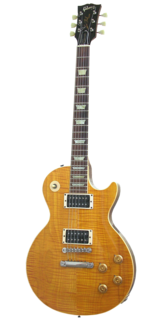
The Gibson Les Paul is a solid body electric guitar that was first sold by the Gibson Guitar Corporation in 1952. The guitar was designed by factory manager John Huis and his team with input from and endorsement by guitarist Les Paul. Its typical design features a solid mahogany body with a carved maple top and a single cutaway, a mahogany set-in neck with a rosewood fretboard, two pickups with independent volume and tone controls, and a stoptail bridge, although variants exist.
The Fender Jazzmaster is an electric guitar designed as a more expensive sibling of the Fender Stratocaster. First introduced at the 1958 NAMM Show, it was initially marketed to jazz guitarists, but found favor among surf rock guitarists in the early 1960s. Its appearance is similar to the Jaguar, though it is tonally and physically different in many technical ways, including pickup design, scale length and controls.
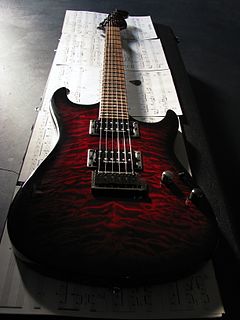
The Fender Showmaster is a discontinued model of electric guitar made by Fender, and is characteristic of a superstrat. Also see the badge change of Stagemaster due to legal reasons.

The Gibson ES-335 is the world's first commercial semi-hollowbody electric guitar, sometimes known as semi-acoustic. Released by the Gibson Guitar Corporation as part of its ES series in 1958, it is neither fully hollow nor fully solid; instead, a solid maple wood block runs through the center of its body. The side "wings" formed by the two "cutaways" into its upper bouts are hollow, and the top has two violin-style f-holes over the hollow chambers. Since its release, Gibson has released numerous variations of and other models based on the design of the ES-335.
The Fender Jaguar is an electric guitar by Fender Musical Instruments characterized by an offset-waist body, a relatively unusual switching system with two separate circuits for lead and rhythm, and a short-scale 24" neck. Owing some roots to the Jazzmaster, it was introduced in 1962 as Fender's feature-laden top-of-the-line model, designed to lure players from Gibson. During its initial 13-year production run, the Jaguar did not sell as well as the less expensive Stratocaster and Telecaster, and achieved its most noticeable popularity in the surf music scene. After the Jaguar was taken out of production in 1975, vintage Jaguars became popular first with American punk rock players, and then more so during the alternative rock, shoegazing and indie rock movements of the 1980s and 1990s. Fender began making a version in Japan in the mid-1980s, and then introduced a USA-made reissue in 1999. Since then, Fender has made a variety of Jaguars in America, Mexico, Indonesia and China under both the Fender and Squier labels. Original vintage Jaguars sell for many times their original price.
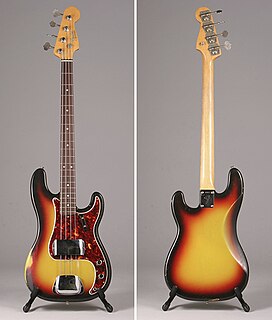
The Fender Precision Bass is a model of electric bass manufactured by Fender Musical Instruments Corporation. In its standard, post-1957 configuration, the Precision Bass is a solid body, four-stringed instrument equipped with a single split-coil humbucking pickup and a one-piece, 20-fret maple neck with rosewood or maple fingerboard.
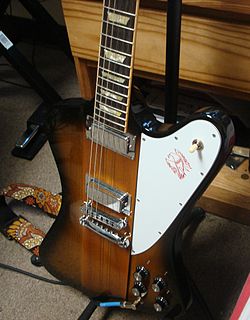
The Gibson Firebird is a solid-body electric guitar manufactured by Gibson from 1963 to the present.
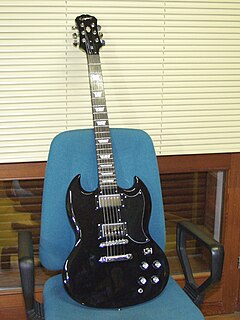
The G-400 is an Epiphone solid body electric guitar model produced as a more modestly priced version of the famous Gibson SG. Currently, Epiphone is a subsidiary of Gibson and manufactures the G-400 and other budget models at a lower cost in Asia. Visually and ergonomically, it is almost identical to a 1962 SG.

The Gibson Hummingbird is an acoustic guitar model/series produced by the Gibson Guitar Corporation.

The Fender Jaguar Bass is an electric bass guitar manufactured in Japan and China by the Fender Musical Instruments Corporation.
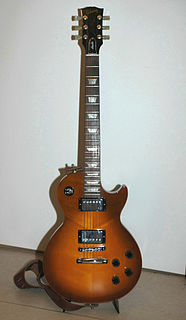
The Gibson Les Paul Studio is a solid body electric guitar produced by the Gibson Guitar Corporation since 1983.
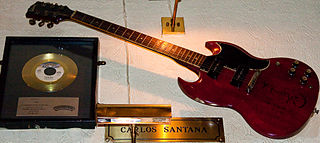
The Gibson SG Special is an electric guitar made by Gibson, that has been manufactured since 1961.

The Gibson Nighthawk was a family of electric guitars manufactured by Gibson. Introduced in 1993, the Nighthawk represented a radical change from traditional Gibson designs. While its maple-capped mahogany body and set neck were reminiscent of the classic Gibson Les Paul, the Nighthawk incorporated a number of characteristics more commonly associated with Fender guitars. The Nighthawk was not a commercial success; production of all models was discontinued in 1998 after only five years.
The Fender Bullet was an electric guitar originally designed by John Page and manufactured and marketed by the Fender Musical Instruments Corporation. It was first introduced as a line of "student" guitars to replace the outgoing Mustang and Musicmaster models.
The Gibson ES series of semi-acoustic guitars are manufactured by the Gibson Guitar Corporation.
The Epiphone Sheraton is a thinline semi-hollow body electric guitar. Though the Sheraton and all its variations were introduced under the ownership of the Gibson Guitar Corporation, Epiphone is the exclusive manufacturer.
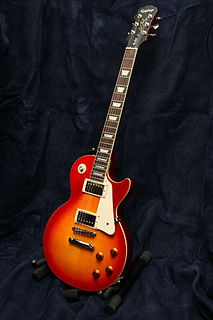
The Epiphone Les Paul is a solid body guitar line produced by Epiphone as a more modestly priced version of the famous Gibson Les Paul. Epiphone is a subsidiary of Gibson Guitar Corporation and manufactures the Les Paul model and other budget models at a lower cost in Asia.

Duesenberg is a brand for electric string instruments founded in 1986 and located in Hannover, Germany. The headquarter is in Hannover, Germany, they are known for using a Plek machine for the levelling of frets and setup. The actual place for production of guitar bodies and necks have never been revealed by Duesenberg e.g. by showing a factory Tour video.
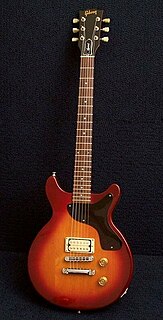
The Gibson Spirit was a guitar model sold under Gibson and Epiphone USA nameplates in the 1980s. This article does not refer to the made-in-China Spirit guitar sold under the Gibson Baldwin Music Education nameplate.